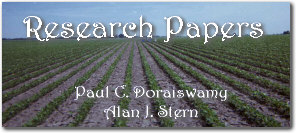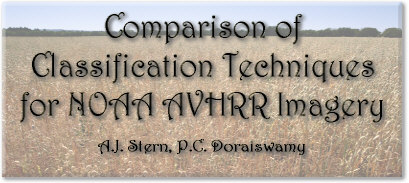| Res16 |

|
|
1 - Res16
2 - Page 2 |

 |  | ||||
| |||||
Alan J. Stern Paul C. Doraiswamy ABSTRACTLandsat TM imagery has been used to create Landuse/Landcover maps for small areas. NOAA AVHRR imagery is generally used for regional and continental scales. Estimating crop acreage at County and State levels is one of USDA's interest. Due to costs and size of image files, it is generally not possible to conduct landuse classifications using Landsat TM imagery for a state every year except in some special cases. The purpose of this study was to compare an aggregated Landsat TM classification with various classification techniques using AVHRR imagery. INTRODUCTIONThe use of satellite imagery to classify and identify crops is one of the primary applications of remote sensing in agriculture. The U.S . Department of Agriculture is engaged in operational and research projects that are focused on improving the methods of crop inventory in the U.S. The National Agricultural Statistical Service (NASS) has routinely conducted crop inventory and classification projects ( Bellow and Graham, 1992). In these projects, NASS has traditionally used Landsat TM data to develop their supervised classification of crops in selecting areas for specific evaluation. The 30m resolution data in the visible and near-IR wavelengths is suitable for classification of crop areas. In general, about two or three images are available for a growing season, and cloud cover may be a problem that reduces the coverage area. Development of an annual and operational assessment of crop classification and inventory for the entire agricultral crop land in the U.S. using Landsat TM data is not feasible. Both the cost of Landsat TM data and the large computing facilities required to conduct such as a task are prohibitively expensive. The Advanced Very High Resolution Radiometers (AVHRR) on board the National Oceanic and Atmospheric Administration (NOAA) polar orbiting satellites provide daily coverage of remotely sensed data at a spatial resolution of 1.1 km. Approximately ten to fifteen near-nadir scnese are available for a growing season with limited cloud cover. The large area coverage was suitable to perform classification of a landscape at regional scales and several investigators have attempted to provide crop classification using AVHRR data. Brown, et al., (1993) provided a very reasonable assessment of vegetation distribution in the entire conterminous U.S. The use of crop-specific masks is limitied to very specific assessessments such as crop acreage estimation at the accuracy level that NASS conducts its inventory. In addition, to single date images of AVHRR data, the Eros Data Center (EDC) creates a maximum Normalized Difference Vegetation Index (NDVI) by compositing AVHRR scenes over a 14 day period (Edenshink, 1992). The area used for growing spring and durham wheat in North Dakota, the study area, has changed from 7.2 million acres in 1988, to 12.5 million acres in 1996, to 9.6 million acres in 1998. Changes in acreage and location where crops are planted can create problems for creating crop-specific maps. It is crucial to have a crop-specific map for each and every year of a multi-year study. As mentioned above, there are many potential sources of AVHRR data. Single date images, or maximum NDVI composites are available. In addition, there are many ways that a wheat crop mask can be created. One way is to perform a classification, however this requires some amount of ground truth which may or may not be available. Another potential way is to use AVHRR scenes after wheat has senesced and make the assumption that low NDVI's are wheat fields that have been harvested. Thus, the purpose of this study is to compare various sources of NOAA AVHRR data and different methods of creating a wheat mask and compare them to a Landsat TM classification which has been aggregated to the AVHRR size pixel. STUDY AREANorth Dakota is a primary growing area for spring wheat and durham wheat, located in the northern Midwestern region of the US. Acreage of spring and durham wheat has varied from 7.2 million acres in 1988 to 12.5 million acres in 1996. The soil and climate conditions of the eastern part of the State are less harsh for cultivating crops than those in the western part of the State. In addition to wheat, sunflower, corn, legumes are grown in the eastern part of the state. The western part of the state is primarily either wheat or grasslands. DATANASS supplied a Landsat TM classified image for North Dakota. In addition, biweekly composites for 1998 were purchased from the EROS Data Center. The biweekly composites are created by using the highest NDVI value for a two week period for each pixel. Single NOAA AVHRR imagery was collected for the following dates: May 16th, May 17th, July 26th, July 27th, August 6th, August 8th and August 12th, The single date data was atmospherically corrected, screened for clouds and registered within 1 km using a procedure described by Che et all. (1994). METHODOLOGYA wheat mask was created by aggregating NASS=s classification using Landsat TM data to AVHRR sized pixels. Pixels with wheat percentage greater than 50% were used. This was deemed to be ground truth and all other classifications would be compared to the wheat classification. This mask is shown in Figure 1. As verification, a summer classification was also created by aggregating the NASS classification and using pixels that were greater than 50% summer crops (corn and soybeans). A mask based on single date imagery was created by stacking Infrared and Red NOAA AVHRR bands into a 6 band image. The three images that were used were May 16/17th, July 26/27th and August 6/8th. Areas of Interest (AOI=s) were created for various areas throughout the state, attempting to get as much variation as possible. 50 classes were created from the classification. This classification was aggregated to 30 meters and compared to the NASS classification, to calculate the composition of each AVHRR class using a technique described in Stern, et al, (1999). Classes containing 30% or more wheat were chosen for comparison. This mask is called Single-county and is shown in Figure 2. A Bi-weekly classification was created using bi-weekly periods:8, 10, 11, 13, 14, 15, 16 and 17. Period 8 corresponds with and period 17 corresponds with This eighteen band image was then classified using the same AOI=s as the single date image. The 50 classes were aggregated and compared to the NASS classification. NOAA AVHRR classes containing 30% or more wheat were chosen. This mask is called Bi-county and is shown in Figure 3. A mask based on late season NDVI was created by using the three late season NDVI images. The three dates; August 6, 8, and 12th were chosen as being relatively cloud free. Clouds were masked and the three NDVI images were merged with the later date taken precedence. Wheat has senesced by early August, so low values of NDVI should be synonymous with wheat fields. Corn and other crops should still be green and have higher values of NDVI. Pixels with NDVI values less than .3 were deemed to be wheat. This mask is shown in Figure 4. The last mask was created by combining two masks. North Dakota straddles at least two ecological climatic zones. The eastern section of the state is wetter and has less grassland than the western part of the state. To create the Eco-mask, the state was divided into these two zones, the eastern section uses the NDVI mask. In the western portion of the state the wheat mask based on NASS's TM image was used because grass and pastureland mimics wheat's NDVI response. In any classification, it is important to calculate the accuracy as a producer as well as a user. The producer's accuracy is generally the number of samples of reference data that were correctly classified. For example, if there are 30 samples of wheat in the reference data but only 28 of them are classified as wheat then the producer's accuracy is 28/30 or 93%. However, it is also important to know how much of the classified wheat should have been classified as something else. For example, if there are 57 samples of wheat in the classified image, but only 28 of them are in the reference data, and the other 19 are supposed to be something else, the user accuracy is only 49%. ( Story and Congalton, 1986). For this reason both accuracies are displayed in Table 1. Bolded values are the highest value for the county and for the particular accuracy ( user or producer). RESULTS AND DISCUSSIONAs expected, the summer crop classification did not match the wheat crop classification in any location. Both masks were pixels that were greater than 50% of their respective crops, and this served as a check to verify that the aggregation was working correctly. Also, as expected the Eco version was very accurate, however, since the western counties were identical to the wheat crop classification (by design), it was not used for overall comparison. Bi-county procedure had the best producer's accuracy in 30 out of 53 counties, and the best user's accuracy in 29 out of 53 counties. The NDVI method was best in 16 and 15 counties, while the single-county method was best in 7 and 9 counties respectively. In any given county the highest accuracy was 69% and 72% respectively. While counties with large amounts of wheat tend to be more accurate than those with very little wheat, placement of that wheat is also important. Large amounts of wheat which are scattered will tend to have lower accuracies than smaller amounts of wheat which are clustered in one area. The bi-county had the best overall state accuracy with 33.6% and 21% for producer and user accuracy respectively. The Single-county had accuracies of 24.9% and 18.9% and NDVI had accuracies of 23.4% and 16.7%. Eco had much higher accuracies of 60.9% and 49.8% which was expected, since half of its pixels are copied from the aggregated Landsat TM. CONCLUSIONThis study has shown that what data is used for classification does make a difference in accuracies. One reason for the increased accuracy in the bi-weekly data versus the single-county is that the bi-weekly used 9 days while the single-county used only 3 dates. The differences between crop combinations is more subtle in AVHRR imagery than in Landsat TM where each pixels is almost always a "pure" pixel and this may be part of the reason. Unfortunately, our resources did not allow us to purchase enough NOAA AVHRR scenes to create a 9 day stack of images throughout the season. ACKNOWLEDGEMENTSThe authors wish to thank Mr. Rick Mueller, USDA/NASS, for assistance with the classification of original TM images. REFERENCESChe N., P.C. Doraiswamy and W. Wie. 1995. An operational method of correction for atmospheric and scan angle effects. Proceedings of the International Geoscience and Remote Sensing Symposium, July 10-14, 1995. Firenze, Italy, Vol 3:1955-1958 Stern, A., P.C. Doraiswamy and P. Cook. 1999. Spring Wheat classification in an AVHRR Image by Signature Extension from a Landsat TM Classified Image Story, M and R.G. Congalton 1986. Accuracy Assessment: A User's Perspective. Photogrammetric Engineering and Remote Sensing, Vol 52, No 3, March 1986 pp 397-399. FIGURES | |||||
| [1] 2 Next >> |





